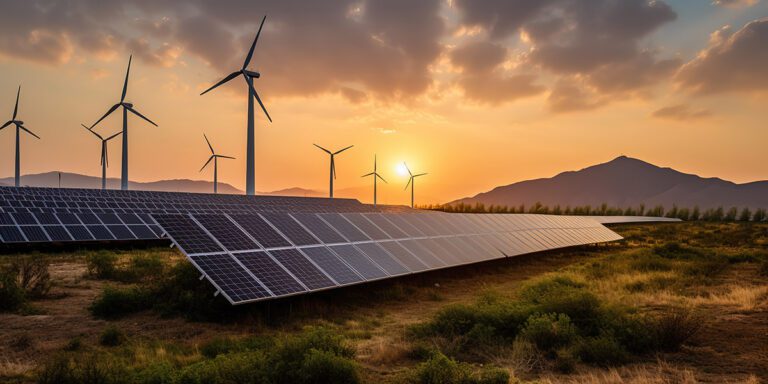This year’s COP28 is a defining moment for climate action. Private and public sector leaders will make critical decisions that will shape the trajectory of our global economy. Here are some of the most consequential topics, according to our advisors.

In March 2023, the Intergovernmental Panel on Climate Change (IPCC) released the final installment of its sixth assessment report (AR6), sounding a sobering warning about the unprecedented scale of recent changes in climate systems.
Not long after, Pope Francis, in his encyclical letter “Laudato Si’,” used the same word – “unprecedented” – to stress the need for systemic change to achieve rapid and profound emissions reductions and adaptation to an overheating planet.
This shared alarm from science and certain faith communities underscores the gravity of the climate crisis and sets the stage for this year’s United Nations Framework Convention on Climate Change (UNFCCC) Conference of the Parties, or COP28, taking place in Dubai from November 30 to December 12, 2023.
The IPCC’s assessment reports, spanning nearly 8,000 pages, paint a clear picture of where the world is headed absent tangible climate action, and form the foundation for COP deliberations, where countries (referred to as “the Parties”) gather to debate, negotiate, and ultimately reach conclusions during the yearly two-week conference.
This year’s COP will be unique in several ways. Here are top topics to watch, according to Coho’s advisors.
Global Stocktake: How Did We Do?
At the heart of COP28 lies the Global Stocktake. The Global Stocktake serves as the world’s climate report card, assessing progress under the Paris Agreement signed in 2015. Under this historic accord, nations committed to three critical goals:
- Reduce emissions to limit global temperature rise to “well below 2 degrees Celsius (3.6 degrees Fahrenheit)” above pre-industrial levels
- Enhance communities’ resilience to climate change impacts
- Align financial flows with low-carbon, climate-resilient development
COP28 will build on the synthesis report, released in September 2023, that lays out 17 key findings after the completion of the technical dialogue on the Global Stocktake. The report overall suggests that while there has been action since the Paris Agreement was signed, that action is insufficient and there is a “rapidly narrowing” window for countries to implement existing commitments and adopt new ones. This report also forms the basis for Parties to work from during COP28 negotiations, and has the potential to shape global, national, and regional climate policy landscapes for years to come.
Energy Transition: “Phase Out” or “Phase Down” Fossil Fuels?
The Global Stocktake synthesis report also emphasized the need for accelerated deployment of existing renewable energy technologies, together with accelerated innovation, development, and transfer of new technologies to support developing countries.
About 60 countries, including hosts UAE, US, and EU, have pledged to work to triple global renewable energy capacity by 2030, in line with a report developed jointly by COP28 Presidency, International Renewable Energy Agency (IRENA), and the Global Renewables Alliance (GRA). A recent US-China statement echoed this commitment. Through a letter to Parties, the COP28 Presidency has urged for fast-tracking energy transition in a just, equitable, and orderly way. Maintaining this fine balance would mean a heightened caution amongst Parties on the negotiating text, and especially the following words – “Phase Out” and “Phase Down.”
Countries are divided on whether to agree to end (phase out) or just reduce their use of fossil fuels (phase down). The EU’s negotiating block recently agreed to push for a global agreement at COP28 to phase out fossil fuels. By contrast, China has said that the complete phase out of fossil fuels is unrealistic, and at COP26 in 2021 led efforts to ensure the final agreement called for a phase down of fossil fuels instead.
Raising tensions on this issue higher, on the eve of COP28, the COP28 president was accused of abusing his position to strike oil deals. At of the time of this article’s publishing, he is denying those allegations.
Whether world leaders agree to “phase out” or “phase down” fossil fuels, corporates must recognize the transition is indeed happening and align their energy procurement and capital expenditure plans accordingly—especially when building new facilities that will lock in new infrastructure for decades to come.
Related article:
Renewable Energy Procurement: How to Set Your Company Up for Success
Corporate Climate Action Pledges: Will Momentum Continue?
In recent years, COP events have become an arena where large players in the private sector announce major climate action pledges. The Glasgow Financial Alliance for Net Zero (GFANZ), where over 650 finance firms across 50 countries have pledged to align their financing activities to achieve net-zero emissions by 2050, and the First Movers Coalition, where about 90 companies have pledged to decarbonize hard-to-abate sectors, were born out of COP26. At COP27, leading organizations from the hydrogen and shipping industry, via a joint statement, pledged to decarbonize the shipping sector by 2050.
This year should be no different. In fact, the COP28 Presidency has made it clear that mobilizing private sector investments is a top priority. The oil and gas industry is likely to make its presence felt with key announcements, as COP28 President-Designate, Dr. Sultan bin Ahmed Al Jaber emphasized the industry’s critical role in accelerating decarbonization by electrifying operations, increasing efficiency, and deploying carbon capture and storage technologies. Under the COP28 Net-Zero Transition Charter, the Presidency has urged the private sector to make science-based, credible, and transparent pledges.
This tightening of pledges would be an important change in the corporate world. A recent analysis by Net Zero Tracker reveals that even though half the world’s largest companies are committed to net-zero, only 4% adhere to best practices in their targets as set by the UN Race to Zero campaign. Research by the Science Based Targets initiative (SBTi) found that only 20% of G20 companies’ climate targets are science-based. Further, a survey of 700 corporate climate commitments suggested that many firms are struggling to deliver, with only around 51% of leaders willing to trade off short-term financial performance to achieve their long-term sustainability goals.
In March 2022, the United Nations established a High-Level Expert Group to develop stronger and clearer standards for net-zero emissions pledges by non-State entities – including businesses, investors, cities, and regions – and speed up their implementation.
Against this backdrop, it will be interesting to see whether COP28 delivers a flurry of corporate pledges or if momentum dies down.
Carbon Markets: Will They Be Operationalized?
Ever since the signing of the Paris Agreement, carbon markets have remained one of the thorniest topics for negotiators. The carbon market, which falls under Article 6 of the Paris Agreement, deserves corporate attention because it informs global supply and demand for mitigation-related activities. These markets have become increasingly vital for driving emissions reductions and removals while simultaneously catalyzing private-sector investments. While the overarching rules of Article 6 were finalized at COP26, the Parties have yet to reach a consensus on how to operationalize them. With stakeholders such as the International Chamber of Commerce urging the full and swift operationalization of Article 6, COP28 could be a crucial year for carbon markets.
Article 6 negotiations hinge on three main subsections:
- Article 6.2 – Allows countries to trade emission reductions and removals with one another through bilateral or multilateral agreements. Outstanding issues include deciding on the authorization framework, registration methodology, and accounting treatment.
- Article 6.4 – Creates a global carbon market overseen by a United Nations entity, where credits, known as Article 6.4 emission reductions (A6.4ERs), can be bought by countries, companies, or even individuals. Parties are conflicted over what methodological principles should govern carbon removals, how A6.4ERs should be assessed, and whether avoidance and conservation enhancement activities should qualify as A6.4ERs.
- Article 6.8 – Provides a formal framework for non-market approaches (NMA) for climate cooperation between countries, where no trading of emissions is involved (for example – technology transfer, capacity building, etc.). Article 6.8, in its current state, is too broad in scope and thus would require significant efforts to quantify and enclose it within a well-defined text.
While Article 6 primarily affects compliance carbon markets, it does have the potential to spill over into voluntary carbon markets. Under Article 6.4, any project seeking registration must comply with 6.4 rules, and while anyone (a company or a country) can buy the credits, it must be authorized and accounted for by the host country.
At COP27, a separate category of Article 6.4 was defined as mitigation contribution units, where units are used to contribute towards the reduction of emission levels in the host country. Using this, a company could retire the units without claiming it for its own emissions but letting the host country claim the reductions towards its own target. Another crucial caveat within Article 6.4 is that 2% of all A6.4ERs are canceled to support overall mitigation in global emissions (OMGE), and 5% of all A6.4ERs proceeds, called Share of Proceeds (SOP), to go to the Adaptation Fund. Increasingly, several vulnerable countries have publicly called on the voluntary market to adopt these mandatory 2% OMGE and 5% SOP rates.
Any movement in Article 6 at COP28 could impact both compliance and voluntary carbon markets. A well-designed global carbon market would garner interest from not only countries scrambling to meet their Nationally Determined Contributions (NDCs) but also private sector companies wanting to trade carbon emissions outside the voluntary carbon market.
Other Topics to Watch
Loss and Damage Fund: Close to the Finish Line?
Last year, at COP27, one of the most significant outcomes was the agreement to establish a loss and damage fund for vulnerable countries hit hardest by climate disasters. Subsequently, a transitional committee was set up to make recommendations on how to operationalize both the new funding arrangements and the fund at COP28. While Parties reached a consensus proposal earlier this November, it will be interesting to see whether the proposal is smoothly adopted at COP28 or debated further.
Climate Finance: The Process Continues
Since the establishment of UNFCCC, one of the most consistent agenda items has been climate finance. This year, too, the COP28 Presidency has urged Parties to deliver on old promises and set the framework for a new deal on finance. Some of the priorities include replenishing the Green Climate Fund, setting a process for a new collective quantified goal on climate finance (NCQG), and scaling the Adaptation Fund.
Geopolitical Crises: An Obstacle to Negotiations?
The wars in Gaza and Ukraine threaten to weaken climate momentum and intensify political tensions during negotiations. Given the energy implications we’ve seen arise from the Russia-Ukraine war, we should expect even more significant repercussions if the Middle East crisis expands across different regions. While their outcomes remain uncertain, these conflicts could affect attendance and the overall atmosphere of COP28 (at the time of this writing, U.S. President Joe Biden had forgone his COP28 attendance to remain focused on the crisis in the Middle East).
Every stakeholder in the climate world must keep a close eye on the developments and decisions made during COP28. The outcomes will impact not only the planet’s future but the current strategic direction of all governments and private and public organizations in the face of an evolving global climate agenda. “Good COP” or “bad COP,” one thing is certain: the decisions made at this gathering will reverberate for years to come.
In early 2024, look for a post on our perspective regarding what actually takes place at COP28. Receive this and all our discussions by subscribing to Coho’s monthly newsletter, The Advisor.


